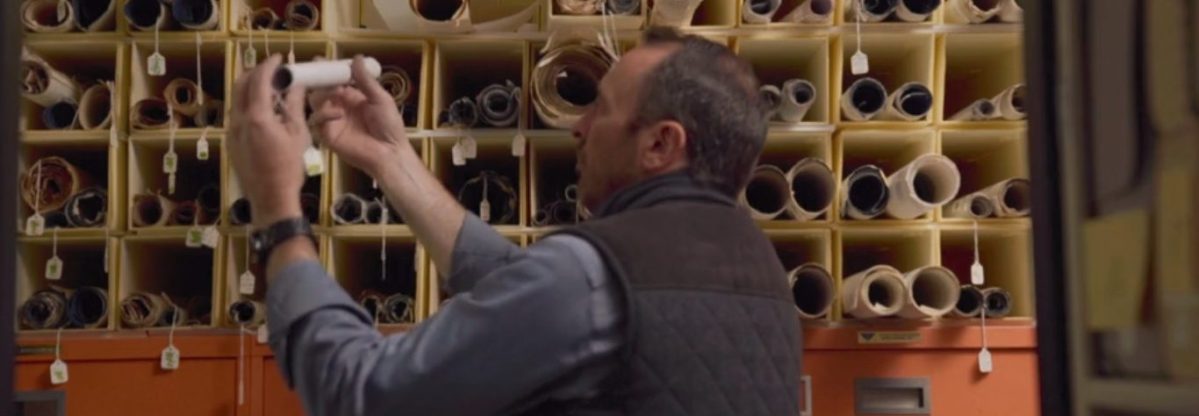Former U.S. Army Special Forces soldier Jack Murphy stood in the basement of a corner building in Belgrade, Serbia and stared at a “death ray.” At least, a drawing of one.
The sketch, pulled from a shelf in an environmentally controlled room, was buried in row after row of documents — some never before seen publicly — belonging to legendary inventor Nikola Tesla, the man who claimed before his death 75 years ago that his latest creation could annihilate a million-man army in a single blast.
“I’m not a TV guy, and I’m not much for melodrama, but it’s hard not to be impressed when you get your hands on original Tesla documents,” Murphy told Real Clear Life in a recent interview. “An actual hand-drawn sketch of the tower… It looks just like something straight out of science fiction.”
Murphy and lifelong Tesla enthusiast Cameron Prince sifted through the usually restricted archives of Belgrade’s Nikola Tesla Museum as part of an investigation for the new show Tesla’s Death Ray: A Murder Declassified, premiering Tuesday on the Discovery Channel. The show follows Murphy and Prince on their four-month quest to figure out if Tesla, a father of the radio and inventor of scores of other world-altering technological advances, really cracked the long-distance energy weapon that would usher in a new era of warfare.
Tesla’s late-in-life assertions about the weapon mostly were dismissed as eccentricities of a brilliant but decaying mind. (Around this time he reportedly once said a pigeon flew to him to say it was dying, and it had “two powerful beams of light” shining from its eyes.)
Tesla said he told the U.S. government he would build them the “death beam” but insisted “on one condition — [he] would not suffer interference from any experts.”
“They would have to trust me,” he said.
The government didn’t go for it, but upon Tesla’s death in January 1943 officials decided that if there was any truth to the claim, it couldn’t be ignored. The U.S. government seized Tesla’s papers and held them for years out of fear some technical military advancement could fall into the hands of America’s enemies, according to declassified FBI documents.
So how close was Tesla to the world-changing weapon? As part of their search, in addition to the Serbian museum archives, Murphy and Prince scoured the FBI files, dug up the ground beneath an old Tesla laboratory site looking for hidden tunnels and, with some engineering help, actually built a smaller-scale “death ray” based on Tesla’s designs.
Murphy said some leads were just dead ends but others panned out with “spectacular results.” To everyone’s astonishment, he said, their version of the “death ray” worked surprisingly well.
A sneak peek of Tesla’s Death Ray: A Murder Declassified that aired Dec. 22 suggested the series is more about the adventure of the investigation and the wonder of the science behind Tesla’s inventions than it is about serious academic rigor. The title basically proclaims that Tesla was killed, but the 86-year-old is reported to have been in poor health for months leading up to his quiet death and historical reports do not indicate foul play. Additionally, a couple of the experts featured in the sneak peak have an obvious and infectious fascination with Tesla, but arguably questionable academic credentials. For instance, one is described onscreen as the author of a book on Tesla, but the sneak peak failed to mention that it is an illustrated children’s book.
Did Nikola Tesla, the greatest inventor in modern history, create a Death Ray? Watch when we uncover the truth Tuesday Jan 2, 10p. pic.twitter.com/Dwg4WgYNNM
— Discovery (@Discovery) December 19, 2017
Murphy, who is curiously identified as a “military investigator,” acknowledged that the series leans toward the sensational in telling the story of Tesla’s life and death, but generally defended it as speaking to serious experts at various stages of the investigation and pointing out legitimate questions that have yet to be answered — like whether anyone stole or tampered with some of Tesla’s papers on their long journey from the New York hotel room, to a U.S. government warehouse, to the museum in Belgrade.
“I think that there’s going to be some value in it for John Q. Public watching the TV show. It’s going to be a fun and exciting show and it’s also going to have some educational value,” he said.
After three-quarters of a century, the militaries of the world haven’t been able to match Tesla’s “death ray” as he imagined it, and real-life directed energy weapons are still in their relative infancy.
Murphy suspects the original weapon may have been impossible, but it stands to reason that the U.S. government would’ve folded Tesla’s work into any number of scientific and defense areas of research, from directed energy to sophisticated communications.
Looking back more than half a century at what Tesla has already achieved and what he was trying to do, Murphy said at the very least, “We can say for sure that he was well ahead of his time.”
This article was featured in the InsideHook newsletter. Sign up now.
























